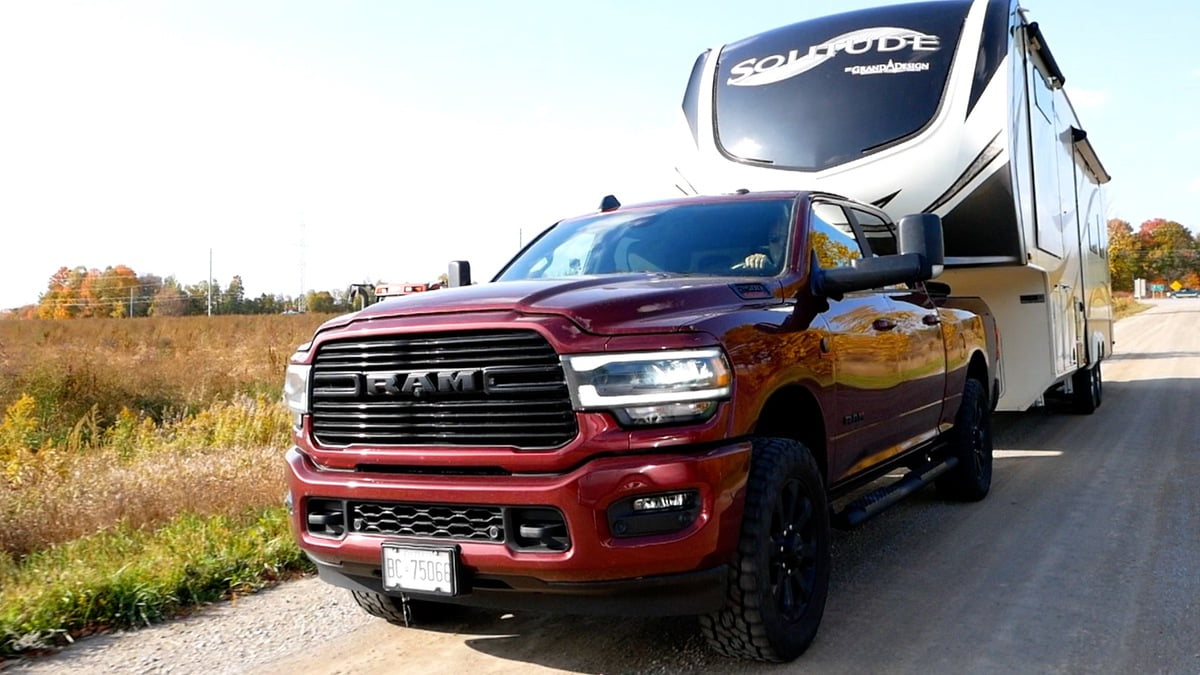As an RVer, you likely know more about towed weight than most, including some salespeople. This comes down to years of hands-on experience. You’re probably familiar with terms like gross weights, maximum weights, pin weights, combined weights, dry weights, tongue weights, and wet weights. But have you ever wondered how accurate the information we get on these weights is?
This is where the real confusion sets in because much of this information is difficult to find, unavailable, or, at best, doesn’t make sense mathematically.
Case Study: My truck and a fifth wheel
I’m using the data for my truck and a used fifth wheel I recently purchased. I’ll demonstrate what I’m writing about, starting with my truck. All these numbers are copied from the official Ram website.
My Truck: 2019 Ram 2500 4×4 Crew Cab 6’4” box
It has a 6.7L turbo-diesel engine, and the transmission is the A6 – 68RFE – auto six-speed. The rear axle ratio is 3.73. Below are the key weight and towing numbers from the website. These numbers appear to reflect a “base” truck in each case. It’s known that each trim level adds base weight and subtracts from the payload. My truck has the Big Horn package, which is only second from the bottom trim. However, it’s suggested that the Big Horn adds 400 lb to the base weight and subtracts that much from the payload listed below. This is where I have a problem. According to Grand Design, the pin weight on my new fifth wheel is 2,350 lb. The math suggests that I’m overweight by 230 lbs. But am I?
Let’s look at all the weights and ratings supplied by Ram and Grand Design.
2019 Ram 2500 4×4 Crew Cab 6’4” box
(From the Ram’s Towing and Payload chart)
Gross Weight Rating (GWR): 10,000 lb
Payload: 2,520 lb
The payload added to the base weight does come out to 10,004.89 lb
Base Weight:
Front axle supports: 4,627.74 lb
Rear axle supports: 2,857.15 lb
Base weight total: 7,484.89 lb
These numbers add up to the total base weight, but then we look at each axle.
Gross Axle Weight Rating (GAWR)
Front axle: 5,750 lb
Rear axle: 6,000 lb
These two numbers add up to 11,750 lb, not the GWR of 10,000 lb
Gross Combined Weight Rating (GCWR)
Truck and trailer: 27,000 lb
GCWR minus GWR is 17,000 lb. However, the Max Trailer Weight Rating is 19,040 lb.
We have two glaring discrepancies.
One is the GWR. How does Ram arrive at this number? It seems arbitrary, and if so, the payload number may also be arbitrary. The second discrepancy is the Max Trailer Weight Rating. It’s more than what the calculation of GCWR minus GWR works out too. Why is that?
The trailer I bought is a 2018 Grand Design Solitude 310 GK.
The following specifications are taken from the Grand Design website.
Unloaded vehicle weight (UVW): 12,100 lb
Hitch Weight: 2,350 lb.
Gross Vehicle Weight Rating (GVWR): 15,000 lb
Length: 34′ 11″
Height: 13′ 5″
Axle Rating:7,000 lb (twin axles)
The two numbers I’m concerned with here are the gross weight and the hitch weight – also known as pin weight. I’m safely under the truck’s GCWR, but the first thing I see on this spec sheet is a thousand-pound discrepancy between what the axles are rated at (14,000 lb.) in total and the GVWR of 15,000 lb. How does this add up?
Secondly, is my hitch weight calculated from the GVWR of 15,000 lb.? If so, it would typically be less in transit, right? How this calculation is arrived at is not clear.
My dilemma
I want to adhere to the manufacturer’s numbers, but in this case, where I’m close to the limits, I can’t determine whether I’m over or under. This is an ongoing problem. Manufacturers publish figures that are less than the maximum weight-bearing capability of their equipment, so we tow less than what they publish to feel safe. But just how much under the actual number are we? The answer is unclear. No one, including the government, seems to know, and manufacturers aren’t communicating. So, where does that leave us when we have a trailer near or just over the limit shown on their websites? I don’t know, either.
I know I’ve asked more questions than I’ve answered here, so the least I can do is give you a quick refresher on what the province says you can tow with what license.
What you can tow in Ontario
In Ontario today, you may tow a Recreational Vehicle (RV) weighing more than 4,600 kg (10,120 lb) with a Class “G” driver’s licence if:
- The towing vehicle is a pick-up truck equipped with the manufacturer’s original box, with a gross vehicle weight rating (GVWR) not exceeding 6,000 kg (13,200 lb) and equipped with no more than two axles and not being used for commercial purposes.
- The combined weight of the pick-up truck and RV does not exceed the gross weight of 11,000 kg (24,200 lb).
- RV hitched to pick-up truck by means of a fifth wheel hitch assembly.
- Only one towed vehicle in combination.
The key thing to remember is that the combined weight does not exceed 11,000 kg. If your truck and trailer weigh more, you must move up to a Class A license (condition R).




